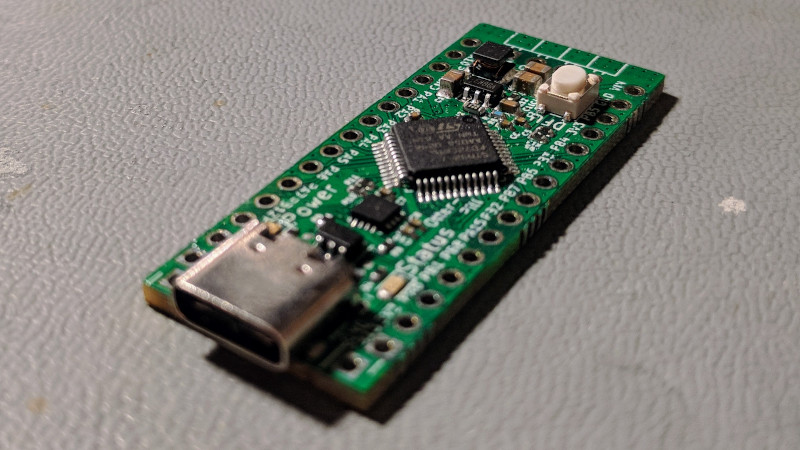The would-be microcontroller experimenter is now faced with a bewildering array of choices when it comes to a tiny development board for their projects. Everything from descendants and clones of the original Arduino through to full-fat Linux powerhouses such as the Raspberry Pi Zero and similar boards can be had, and often for a reasonable price.
A new entrant has now joined the fray, the OtterPill is an STM32F072-based board with an Arduino-Nano-like pinout, and it comes from the bench of [Jana Marie]. With so many competitors you might ask yourself what it can offer, and it would be a valid point given that a Nano clone can be had for relative pennies. Aside from the Nano shield compatibility and extra power of the ARM Cortex M0 then, it’s an open source development board with USB-PD included from its USB-C socket, and with some elite BoM wizardry she’s managed to get the cost of its components to below three dollars. A USB-PD example firmware is available and a blank firmware is on its way. For now the board exists only in prototype form, but she’s putting together a production run if you would like one too. We saw an early development of it at eth0 back in the autumn, and given the progress since then we’re sure that we won’t have to wait for long.
Regular readers will recognise [Jana Marie]’s work, because otter-themed boards have made their way to these pages before. Our most recent ones were the USB-C replacement board bringing USB-PD to the TS-100 soldering iron, and a nifty little USB board for addressable LEDs.
















Otters are necrophiliacs.
Ever seen Michelle Wolf’s new show? Put simply, stop judging animals by human standards. It really doesn’t work that way.
“Put simply, stop judging animals by human standards.”
Intelligence standards. Oh wait…
Different species of otters behave in different ways.
Uh oh. *throws away Otter Box*
Yep, and I guess no more jumping out of Twin Otters. :(
I’m totally lost in the world of microcontrollers… there are just so many to choose from these days. It would be nice if there was a comparison guide to quickly summarize the pros and cons, and provide details for some “good” reading.
The advantages of one 32bit processor over another are minor these days. If you have a controller that does the job keep using it. If you don’t like it use something else. At the moment it’s all ARM based, there are a few flavours of processor core but don’t worry about it.
This one is an arduino with STM32M0 but not an arduino. Similar to blue pill. If you are doing nothing too complex it will be fine. If you don’t want arduino IDE you can use the tools supplied by the manufacturer like STM32CubeMX in combination with SW4STM.
Meh. I pretty much just use the esp8266 or esp32 for everything. Dirt cheap. Built in wifi. The 32 is 32 bit and has BLE and loads of interesting GPIO options.
I’m sure there are better options for specific applications but these fit the bill for all of my tinkering.
the Esp8266 is 32 bit too…
You generally find out that a chip is suitable/not suitable for your use case only when you made your first dozen prototypes, examples are Using blackpill for CAN bus to find out it’s USB stack and CANbus cannot operate at the same time, You choose a PIC32 because it can use CAN and USB at the same time only to find out the chip is not available in SMC for low pin count devices or it’s not available with your required flash size. Other times you grab a SOC chip or dev board as it’s just hanging about or cheap and find that it’s super suitable for Project A that you are working on as luck would have it.
These are just examples based on my experience, as to which chip/brand you buy again depends on many factors but normally i will choose chip A over chip B if chip A is supported in platformio/arduino.
I would recommend anyone wanting to choose a chip start off with a few DEV boards from various manufacturers, example ST32 -st micro, ATMEGA-atmel , PIC-microchip , in that order. pic micro has difficult/large/not optimised IDE for me but someone like ben heck will reach for a PIC and program at machine code level where you might want a atmega in arduino dev environment or even a drag and drop program environment.
So the main strength is usb power delivery? So this board can programmatically power other boards/devices with higher current/voltage? And the cortex m0 is good enough for such custom power delivery firmware? Because for generic board to handle e.g. micropython 16KB ram/128KB flash is quite limited. BTW, still waiting for new STMF401 based pill board mentioned here recently (e.g. https://www.aliexpress.com/item/4000068998794.html)
16KB/128KB? Luxury. When I was young we only had four bits to rub together, and two of them had to be zero!
Amen brother!
You rubbed your bits?
Look away! Look away!
divide by zer0 run time err0r
They must have been the naughty bits.
Check out This lackaday project for answers to your questions about implementing USB power delivery.
Oh, great, thanks, it even uses same STM32F072.
You can always desolder the stm32f103 and put any compat stm32 there. I did this with the stm33l443. There are lots in the 7×7 48pin lqfp pinout to choose from.
Awww, I was hoping for the Allwinner F1C100S, so I could make a smartwatch that runs puppy.